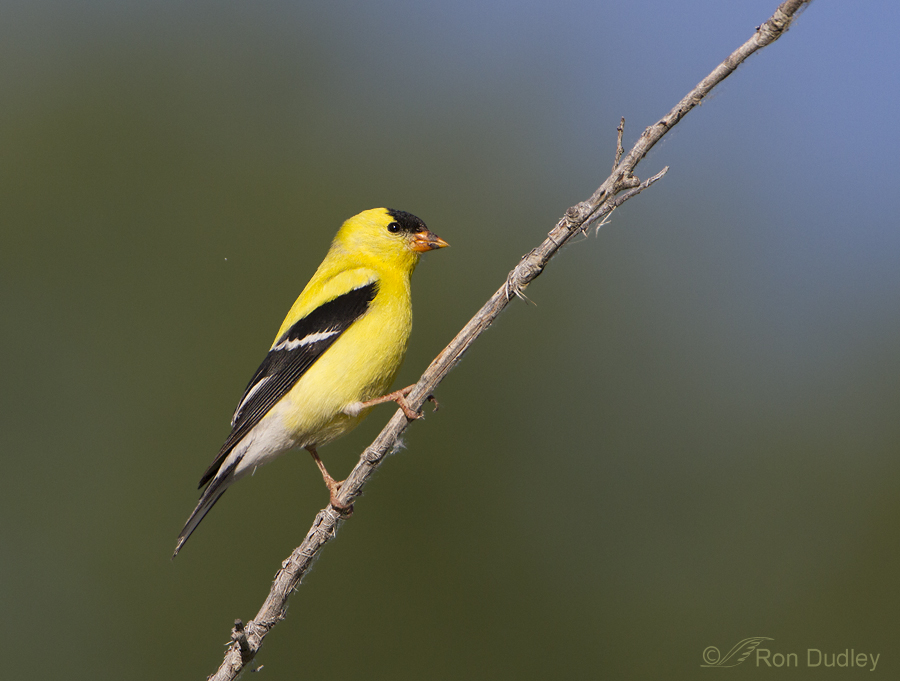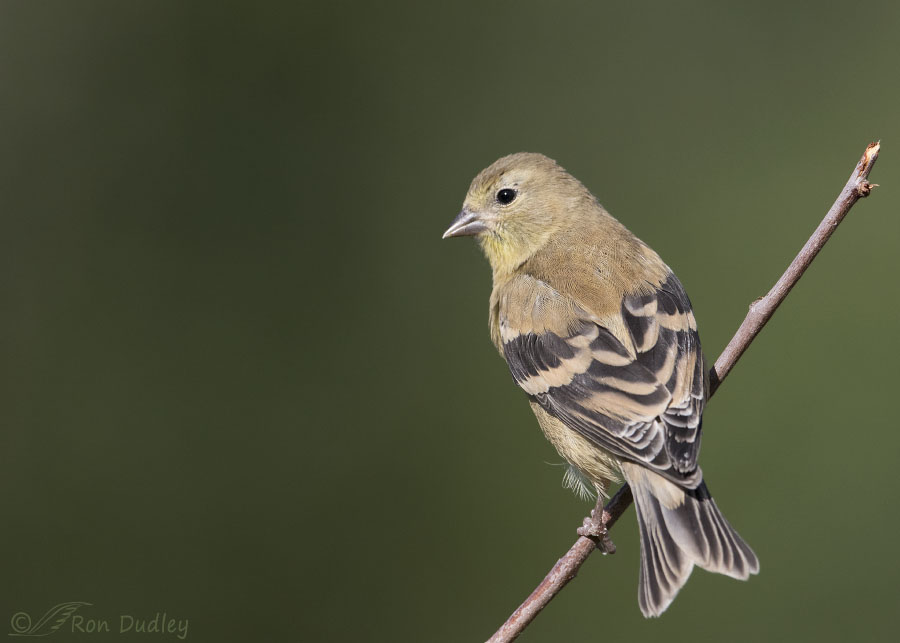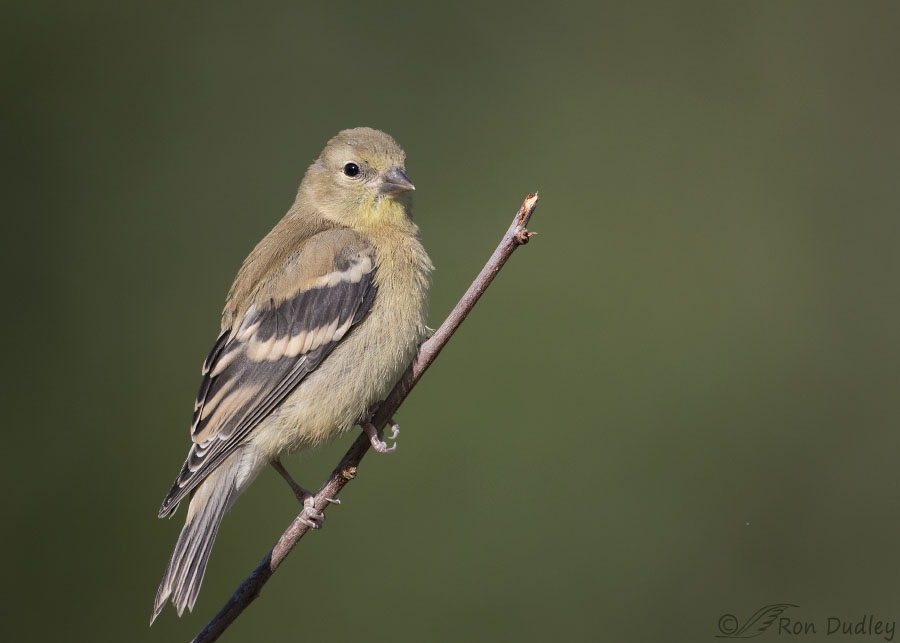For some reason I seldom see and rarely photograph juvenile American Goldfinches. Until recently I didn’t realize how striking and distinctive their wing patterns and colors are and how different they are from the adults.
 For the sake of comparison here’s an adult male in breeding plumage. Females and adult males when not in breeding plumage are much less bright than this guy but the patterns remain quite similar.
For the sake of comparison here’s an adult male in breeding plumage. Females and adult males when not in breeding plumage are much less bright than this guy but the patterns remain quite similar.

1/2500, f/6.3, ISO 800, Canon 7D Mark II, Canon EF 500mm f/4L IS II USM + EF 1.4 III Extender, not baited, set up or called in
But the juveniles look much different.
This unusually cooperative juvie appeared right in front of my lens four days ago in the Wasatch Mountains and proceeded to give me some nice poses. The photos are of the BOS variety (bird on a stick) but that’s perfect for my purposes here.
The whites of the adult male are instead a buffy color in the juvenile and his jet-blacks are brownish-black in the youngster. And the bright yellows of the adult male are brown overall in the young bird. But I think it’s the more complex patterns on the wings and tail, even more than the colors, that struck me most. I really had no idea…
Personally I prefer the juvenile to the adult male aesthetically. Males in breeding plumage are just a little garish for my tastes (for what that’s worth and not that it really matters).

1/2500, f/6.3, ISO 800, Canon 7D Mark II, Canon EF 500mm f/4L IS II USM + EF 1.4 III Extender, not baited, set up or called in
I thought I’d throw in a side view of the same bird to give you a more complete look at the immature goldfinch. Here it’s fluffed up a little.
On another subject I thought I should mention that my recent opportunities with large numbers and a good variety of birds have quickly gone to hell in a handbasket. For the last couple of weeks I’ve been spoiled by almost a glut of songbirds in the mountains feeding on ripening berries and I’ve taken full advantage of the situation. Many days it’s been a little smoky from the California fires but it’s been manageable for photography most of the time, especially in the mountains above some of the smoke in the valleys.
But recently many wildfires have erupted in southern and central Utah and monsoonal “moisture” (we’ll see about that up here but they’re being flooded in southern Utah) and the accompanying south breezes have brought dense smoke our way. Yesterday our air was absolutely disgusting in both the mountains and the valleys and forecasters say there’s no relief in sight.
It’s mostly a waste of time and gas to try to photograph birds in that smoke so I feel like I’m grounded and yes I’m a little cranky about that. So eventually I may have to resort to posting a few older photos again.
Smoke and s*** happen.
Ron


Lovely pics of a beautiful youngster. I greatly appreciate your BOS shots – especially of quick little songbirds like this one. They give me an opportunity to linger over subtleties my eyes could never catch.
I once spent a very pleasant summer afternoon near a New England beach watching multiple pairs of goldfinches dart in and out of a high hedge. The females are also quite attractive in their olive jackets.
Well, so now your are making get my binoculars out for the dozens of goldfinches at my feeders all day long. I’m wondering if there is a way to differentiate juvenile male from female? None of my guides do so. I find the adult male in breeding plumage making a statement that human males can only dream about, although the muted colors of the juvenile seem more refined and sophisticated. How’s that for anthropomorphism!
“I find the adult male in breeding plumage making a statement that human males can only dream about, although the muted colors of the juvenile seem more refined and sophisticated”
I love the way you said that, Lyle. Perfect! I wish I’d thought to say something similar in my text. Take a bow.
The young Goldfinch is very different. Cute as can be. The smoke is bad. Twice we kept smelling smoke, and saw the smoke, but never figured out where the fire was. So we chalked it up to bad air. I feel for the wild life that have to live in those conditions.
Jean, sometimes the smoke can be very thick here and I can barely smell it. Other times it stinks.
As they, themselves, say, “Sweeeet!Sweeeeet’ Sweeeeetee!”
🙂
I wonder whether the less garish colours are a camouflage thing? I am a fan of both the subtle AND the loud where birds are concerned. Much less so in people.
Sigh on the smoke issues. It sucks. I hope you, and the critters who can’t hunker down inside away from it, get some relief soon.
“I am a fan of both the subtle AND the loud where birds are concerned”
Often, I am too, EC. And I don’t dislike the bright colors of the adult male. I just prefer the juvenile’s more subtle approach.
Ron, I have only recently subscribed to your website, and I am most appreciative of your photos and input. I do not have Canon equipment, but excellent Nikon cameras ad lenses. However, the longest lense i have is the 80-400 and a 1.4x extender. I hope that doesn’t make it difficult to replicate the quality of what you are achieving, or do you think a 500mm lens is a significant advantage?
Also, I visit relatives in Utah, and typically go up the canyons for landscape beauty, and then go east of Park City to Kamus/Woodlands area. When you refer to the Wasatch Mountains, where specifically do you go for birding? Thanks.
“do you think a 500mm lens is a significant advantage”
It depends on what type of shooting you usually do. Here in Utah it would be a significant advantage to have the 500 but I have a friend who used to live in Florida where birds are generally much easier to approach and even though she has a 500mm lens now she often misses the shorter reach lenses when birds are close.
Sorry, for a variety of reasons I don’t give out specific locations.
Oddly, I seem to be more drawn to subtlety rather than the garish, although I appreciate both for their outrageous beauty. The subtlety forces you to linger and listen to the whispers of beauty, pondering the intricate details whereas the garish screams it out loud at the top of trees and DEMANDS your immediate and complete attention. When I lived in Dallas, I never got to see goldfinches in their breeding plumage. They saved that for the northern part of their annual migration.
As usual, your photography is excellent, and personally, I don’t mind the bird on a stick at all. Sticks and branches are good perches!
Thankfully, we don’t have much of the smoke here, but the dust is everywhere. While Flagstaff and Phoenix are hogging all the rain, at my house and the surrounding area, we haven’t had more than two light sprinkles (and using the word sprinkles is really an exaggeration). I had great hopes for some rain last night, but it split and went north and south, close enough that I could smell it, but not enough to do more than count the drops or wet anyone’s whistle. So frustrating that it was so very close–no more than a mile either way.
And Dick Harlow, yeah, you’d THINK there would be some form of common sense about climate change, but you’d be WRONG!
You make some good points about “garish” vs “subtle” when it comes to colors of birds, Laura. I agree.
Thanks for the lesson about young goldfinches. I think I’ve just assumed the juvies are already in winter plumage. Live and learn.
Love your songbirds! I’ve really enjoyed your daily blog, and I’m glad you’ve been able to continue it. We’re all mortal, but I hope your relative health holds, and you can keep it coming for a very long time–both for your sake and for all your readers, including me.
The variety of summer birds has been wonderful. We’ll both be back to the relative stability of winter birds before we know it. And by then, thank goodness, the smoke will be long gone. Living in the West is becoming tougher in a new way. Fortunately, the Denver area has gotten the benefit of some of the monsoons, even though the western and southern part of the Colorado are still suffering. We’re still a couple inches below normal.
“I think I’ve just assumed the juvies are already in winter plumage”
I probably assumed the same thing, Nancy. I’ll be looking for young birds more often now.
Excellent shots, sharp, should be in a book, fun post. But I’m sorry – for being a pessimist concerning Western fires. The East coast is getting hammered with rain, but inland, where we are, although some of us have had showers we are below monthly averages. One would think that there would be some form of common sense concerning climate change by our govt.
It’s hard not to be a pessimist about the fires and smoke, Dick. It’s likely to only get worse as time goes by.
I have had a hard time identifying juvenile gold finches and juvenile lazuli buntings. To me they look very similar.
I am greatfull to be in St George this week. The heavy rain was delightful and the blue shy is beautiful this morning. I wish I had more time to bird but we have a business agenda this week.
I think they look similar too, April. I heard there was flooding down there yesterday in the general area of St. George.
Always a joy to open my email to a notification from your blog. Your commentary is as entertaining as your photos are beautiful. Hope the fires are extinguished and the smoky inversion dissipates soon. Perhaps your yard eagle will come to visit and provide some photo ops.
Thank you for the kind words about my blog, Melanie.
That eagle, if it appears at all in my yard, always shows up in December or January so I think it’ll be a long wait…
Love both pictures. But have to say that bright yellow is beautiful. I’m looking forward to them coming to my feeder again.
As for the smoke, boy is it bad. We’re right in the middle of three of the fires. So with the wind direction we get some constantly.
Knowing over a thousand homes were lost up in Redding CA I try not to complain about the smoke.
Have a great day ❗️
You’re right, Diana. It’s all relative. If I’d lost my house to far I’d gladly trade that outcome for smoke, of just about any density.
I’ve seen a lot of American Goldfinches, but if I’ve seen a juvenile, I’ve been totally unaware. Thank you for posting the photos of one. As for “stuff” that happens, I completely understand being cranky. I am grateful to live in an area that, at least in my 10 years here, doesn’t get that stuff. All we get is dust storms that obliterate the mountains that are very close by (in the middle of the city).
I’ve seen some of the videos of your dust storms, Susan. They’re definitely intimidating as they approach.
They really are exceptionally sharp shots Ron. Nice when the birds take a couple minutes to pose for us. Sorry about the smoke, but as you say – smoke happens 🙂 Possibly some of your smoke is floating on the wind from Northern California.
Everett Sanborn
Prescott AZ
I’m sure some of our smoke is coming from CA, Everett. But right now at least most of it is coming from central Utah.
I totally agree with your assessment of the breeding male. These photos of the juvenile are terrific and he is a far better looking bird. The second photo is really special…that feather pattern and the color combination is great. I love the soft blending of the colors…buffy-tan and soft black…beautiful! Well now you have prompted me to get some pictures of goldfinches! I have so many of them at my feeders that I don’t photograph them so I’ve never really checked out the coloring like this. Sometimes we overlook what’s right in front of us. A project for this morning. 🙂
“Sometimes we overlook what’s right in front of us”
Boy, isn’t that the absolute truth, Kathy! I wonder how many of the juvies I’ve seen but ended up largely ignoring. Stupid me…
Ron: Nice sharp shots. Now, as to the garish adult male, it is a bird for all tastes: garish for breeding, and beautifully muted in the winter – called a “butterscotch” in some places. What more could one ask for?
“it is a bird for all tastes”
I’d agree with that, Richard. Tastes are certainly personal and that’s a good thing.